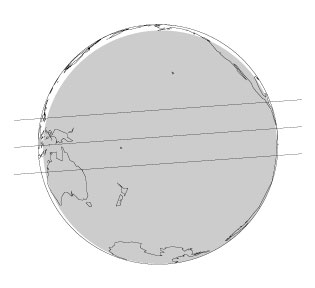P571 Occultation June 24, 2008
(last updated 2008 04 04)

The shaded area represents where the sun is more than 12 degrees below the horizon. Across the globe pictured above, the three lines correspond to the northern limit, centerline, and southern limit of Pluto's shadow. The northern and southern limits correspond to a radius of 1208 km (the 50% normalized stellar-flux level) for Pluto.
|
| Geocentric Mid-time (yyyy month dd hh:mm:ss) |
2008 June 24 10:38:15± 00:00:17 UT |
| Minimum Geocentric Separation |
0.017± 0.020 arcsec |
| Position Angle (Pluto relative to the star; measured north through east) |
–4.13 degrees |
| Geocentric Velocity |
23.7 km/sec |
| Prediction Version |
P571-AST-2.0 |
Reference star position:
(USNO-B1.0, at epoch of event) |
RA (h:m:s; J2000) |
Dec (d:m:s; J2000) |
R Mag1 |
| P571 Catalog2 |
17 58 22.3687 |
–17 02 49.150 |
15.8 |
| P571 Measured |
17 58 22.3856 |
–17 02 49.202 |
|
1From USNO-B Catalog.
2USNO-B, at epoch 1972.9.
|
|
Offsets from Reference Position/Ephemeris3 |
| Body |
RA (arcsec) |
Dec (arcsec) |
Notes |
P571 |
+0.2637± 0.0117 |
–0.048± 0.011 |
From 52 frames |
| Pluto4 |
–0.0509± 0.014 |
+0.096± 0.017 |
See note 5 |
3All "offsets" are defined in the ("corrected" – "reference") or ("observed" – "calculated") sense. The offsets should be added to reference positions to get the measured positions, which we use to calculate the prediction.
4The reference position for Pluto is that given by JPL Horizon's ephemeris (Pluto source file: PLU017; Earth center source file: DE405).
5255 strip scans and 89 USNO-61inch Telescope frames were used to develop a model to fit the residuals obtained from our measured positions compared to that of the object's JPL ephemeris.. The model includes the first-order effects of errors in the orbital elements of Pluto: (i) constant offsets in RA and Dec, (ii) linear (in time) offsets in RA and Dec, (iii) sinusoidal terms with the Earth's orbital period, and (iv) sinusoidal terms with the Pluto-Charon mutual orbit.
|
Discussion
On June 24th, 2008, Pluto will occult P571 (=USNO-B 0729-0691269; as originally published in McDonald & Elliot 2000a, 2000b; Table). The above map and the following prediction results are from the analysis of 255 strip scans obtained at the Lowell Observatory Astrograph by Rosemary Pike, Amanda Bosh, and Allison Moberger during 2005-2008 (the strip scans from earlier years did not contain Pluto-Charon images) and 89 frames taken on 2005 and 2007 by Steve Levine with the 1.55-m Kaj Strand Astrometric Reflector.
The corrected RA and Dec for USNO-B1.0 star 0746-0365410 are J2000 coordinates at the epoch of the event. A linear model was used to fit for the proper motion of the star. We then used the fitted model to determine the star's measured position (listed above) and error at the event mid-time.
Prediction Notes
- The Pluto radius of 1208 ± 9 km for a 50% for a partial occultation by the atmosphere is from Elliot et al. (2007).
- Archive of all P571
occultation predictions based on alternate sources
of data, including past predictions.
Site Information
Site |
East Longitude |
Latitude |
Altitude7
(km) |
Distance8
(km) |
Velocity
(km/s) |
Flagstaff |
–111 44 23 |
35 11 02 |
2.31 |
3778 N. |
23.99 |
Hobart |
147 26 24 |
–42 48 18 |
0.043 |
3346 S. |
23.95 |
IRTF |
–155 28 29 |
19 49 46 |
4.18 |
3348 N. |
24.17 |
Las Campanas |
–70 42 00 |
–29 00 30 |
2.28 |
3760 S. |
23.74 |
Lick Obs. |
–121 38 12 |
37 20 36 |
1.29 |
4168 N. |
24.03 |
Magdalena Ridge Obs. |
–107 11 05 |
33 58 36 |
3.18 |
3569 N. |
23.97 |
Mt. John |
170 27 50 |
–43 59 22 |
1.041 |
3240 S. |
24.03 |
Siding Spring |
149 03 44 |
–31 16 17 |
1.205 |
2157 S. |
23.99 |
Geocentric |
---------- |
--------- |
center of Earth |
389 S. |
23.74 |
7Altitude of each observatory is measured in kilometers above sea level.
8"Distance" refers to the closest approach distance of the "Site" to the center of Pluto's shadow in the shadow plane. The errors on all closest approach distances are ±443 km (one standard deviation). "S." means the site is South of the center of Pluto's shadow. "N." means the site is North of the center of Pluto's shadow.
P571 Appulse Predictions for Individual Sites
Site |
Pluto Immersion (UT)9 |
Mid-Time (UT)9 |
Pluto Emersion (UT)9 |
Solar Elevation 10 |
Flagstaff |
----------- |
10:35:13 (18°) |
----------- |
–16° |
Hobart |
----------- |
10:40:54 (42°) |
----------- |
–42° |
IRTF |
----------- |
10:37:32 (52°) |
----------- |
–47° |
Las Campanas |
----------- |
10:34:29 (6°) |
----------- |
–12° |
Lick Obs. |
----------- |
10:35:42 (23°) |
----------- |
–20° |
Magdalena Ridge Obs. |
----------- |
10:35:01 (17°) |
----------- |
–15° |
Mt. John |
----------- |
10:39:49 (56°) |
----------- |
–59° |
Siding Spring |
----------- |
10:41:10 (45°) |
----------- |
–44° |
Geocentric |
10:37:17 |
10:38:15 |
10:39:13 |
|
9The errors on all times are ±0:17 (17 seconds; one standard deviation). In parenthesis is the elevation of the body above the celestial horizon in degrees.
10At the closest approch time for that location.
** Internal note: A– (20080404) **
Last updated by Carlos A Zuluaga (czuluaga@mit.edu)
2008-04-04 12:00
Please direct all inquiries to Planetary Astronomy Lab (planetary-astronomy@mit.edu)
Accessibility
